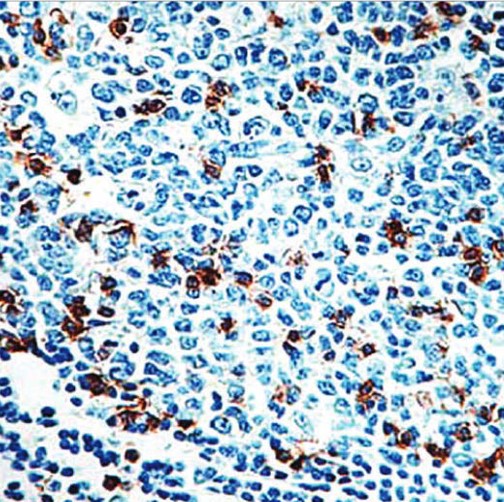Anti-CD57 Antibody (34054)
$209.00
Overview
Product Name Anti-CD57 Antibody (34054)
Description Anti-CD57 Mouse Monoclonal Antibody
Target CD57
Species Reactivity Human
Applications IHC
Host Mouse
Clonality Monoclonal
Clone ID G539.1
Isotype IgG1
Immunogen Recombinant human CD57.
Properties
Form Liquid
Concentration Lot Specific
Formulation Tris buffer, pH 7.3-7.7, 1% BSA, 0.1% sodium azide.
Buffer Formulation Tris
Buffer pH pH 7.3-7.7
Buffer Anti-Microbial 0.1% Sodium Azide
Buffer Protein Stabilizer 1% Bovine Serum Albumin
Format Purified
Purification Purified by immunoaffinity chromatography
Specificity Information
Specificity Human CD57. Reactivity with other species has not been investigated.
Target Name Galactosylgalactosylxylosylprotein 3-β-glucuronosyltransferase 1
Target ID CD57
Uniprot ID Q9P2W7
Alternative Names EC 2.4.1.135, β-1,3-glucuronyltransferase 1, Glucuronosyltransferase P, GlcAT-P, UDP-GlcUA:glycoprotein β-1,3-glucuronyltransferase, GlcUAT-P
Gene Name B3GAT1
Sequence Location [Isoform 1]: Golgi apparatus membrane, Secreted, Endoplasmic reticulum membrane, Secreted
Biological Function Involved in the biosynthesis of L2/HNK-1 carbohydrate epitope on glycoproteins. Can also play a role in glycosaminoglycan biosynthesis. Substrates include asialo-orosomucoid (ASOR), asialo-fetuin, and asialo-neural cell adhesion molecule. Requires sphingomyelin for activity: stearoyl-sphingomyelin was the most effective, followed by palmitoyl-sphingomyelin and lignoceroyl-sphingomyelin. Activity was demonstrated only for sphingomyelin with a saturated fatty acid and not for that with an unsaturated fatty acid, regardless of the length of the acyl group. {UniProtKB:O35789}.
Research Areas Cancer research
Background It was originally believed that CD57 (cluster of differentiation 57) was uniquely expressed on natural killer (NK) cells, but further research showed that CD57 was expressed only on a subset of functionally distinct NK cells. CD57 was subsequently identified on CD8+ T cells as well as on cells of neural crest origin. In neural cells, the CD57 epitope is predominantly restricted to adhesion molecules. CD57 has been utilized as a marker for tumors of neuroendocrine origin including pheochromocytomas, paragangliomas, carcinoid tumors, medulloblastomas, neuromas, neurofibromas, schwannomas, and granular cell tumors. Expression of CD57 can be used to distinguish nodular lymphocyte-predominant Hodgkin's lymphoma from T-cell/histiocyte-rich large B-cell lymphoma, nodular sclerosis, Hodgkin's disease, and follicular lymphoma.
Application Images


Description Immunohistochemistry: use at a dilution of 1:100-1:200 on formalin-fixed, paraffin-embedded samples after heat-induced epitope retrieval at pH 9 for 10-30 minutes. Detection of CD57 in Hodgkin’s Lymphoma with #34054 diluted 1:100-1:200.
Handling
Storage Store at 2-8°C. Do not freeze.
Dilution Instructions Dilute in PBS or medium that is identical to that used in the assay system.
Application Instructions
Immunohistochemistry: use at a dilution of 1:100-1:200 on formalin-fixed, paraffin-embedded samples after heat-induced epitope retrieval at pH 9 for 10-30 minutes.
Immunohistochemistry: use at a dilution of 1:100-1:200 on formalin-fixed, paraffin-embedded samples after heat-induced epitope retrieval at pH 9 for 10-30 minutes.
References & Data Sheet
Data Sheet  Download PDF Data Sheet
Download PDF Data Sheet
 Download PDF Data Sheet
Download PDF Data Sheet


